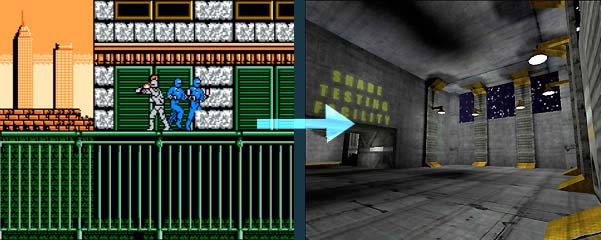
Videogame Physics:
Introduction
Early Video Game Physics
Modern Video Game Physics
Dynamic Objects
Ragdoll Physics
Physics Hall of Shame
Bibliography/Links

Modern Game Physics
Immersion, Polygons, and Blowing Stuff Up!
When games made the leap into 3D, the world presented became considerably more realistic. Despite the fact that most early texture-mapped 3D games were ugly as sin, they were still more realistic then 2D games because they presented a world similar to ours. The player could now look and move in all directions. This made games considerably more immersive. Many cantancerous old gamers complain that 2D games offered better gameplay, and while this may be true, it's much harder to immerse yourself in a 2D game.
With the new immersive possibilities presented by 3D came a need for more realistic physics. If the world you're moving around in looks realistic, it might as well behave realistically. Unfortunately realistic physics are extremely compuationally expensive, not to mention difficult to implement. Simulating the complex behaviors of real objects at 60 frames per second requires a fast processor and a dedicated graphics processor to take off some of the CPU's heavy load.

Left shot is one I took of Data East Software's "Bad Dudes" for the NES. Right shot is of my very own 3D engine 'Shade', and is there solely to stroke my ego.
Because of these compilcations, modern games fudge it as much as possible. 'Fudging it' is the keyword when creating video games. Curved surfaces are approximated by polygons which can be rendered blazingly fast by today's video cards. Collision detection isn't 100% accurate, bits of people and creatures clip through walls. The list goes on and on. If it looks good while you're running around blowing stuff up, it's good enough. The better looks, of course, the more likely people are to be excited. But nothing gets people excited these days like realistic physics.
By far the greatest example of modern videogame physics is the Havok Game Dynamics SDK(software development kit), which is used to great effect in Valve Software's Half-Life 2. It will serve as a good tour for some of the techniques used in today's 3D games. The Environmental Rigid Body Dynamics and Ragdoll Physics pages have more information on today's physics-based games and cite the Havok engine frequently.